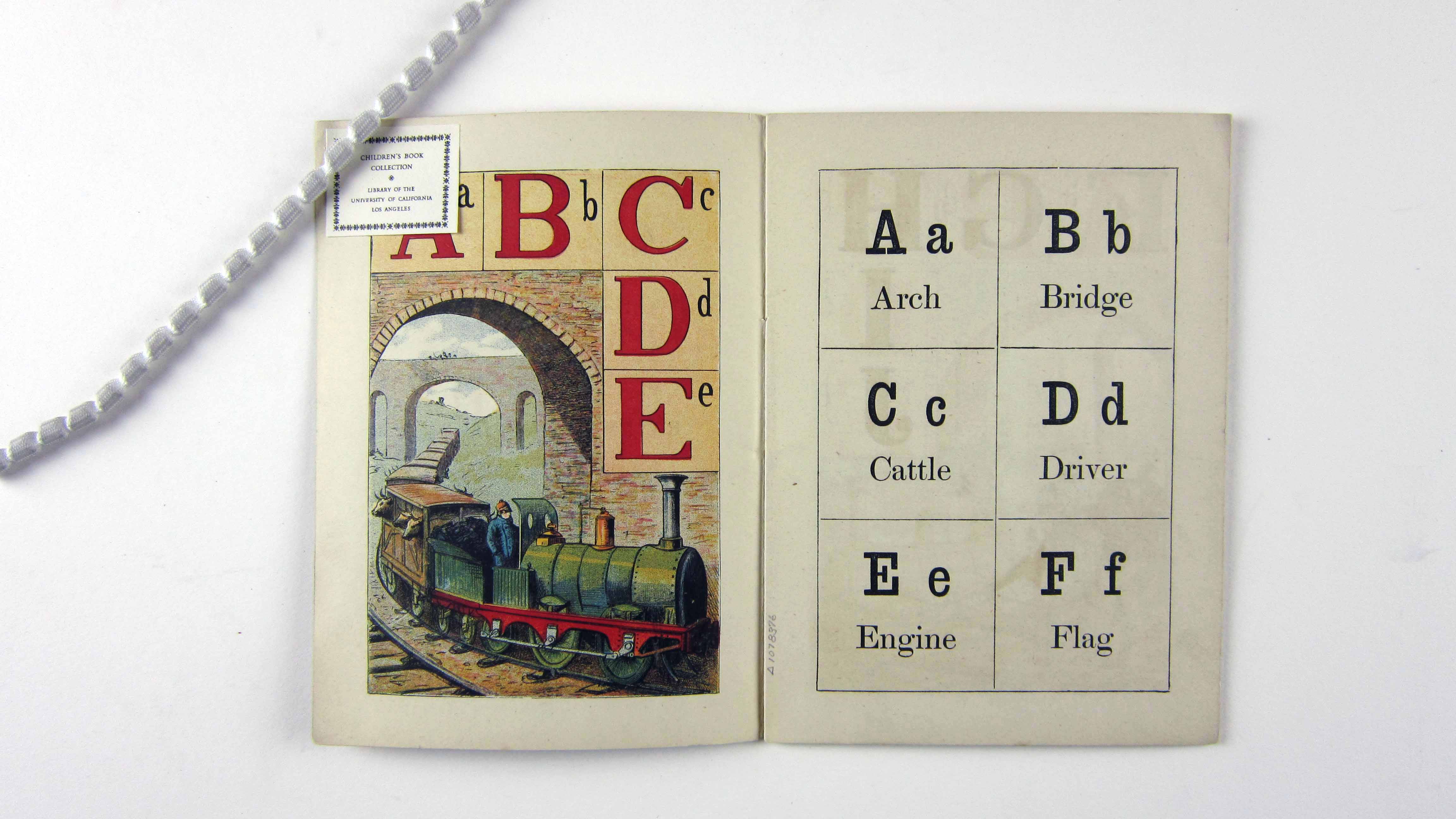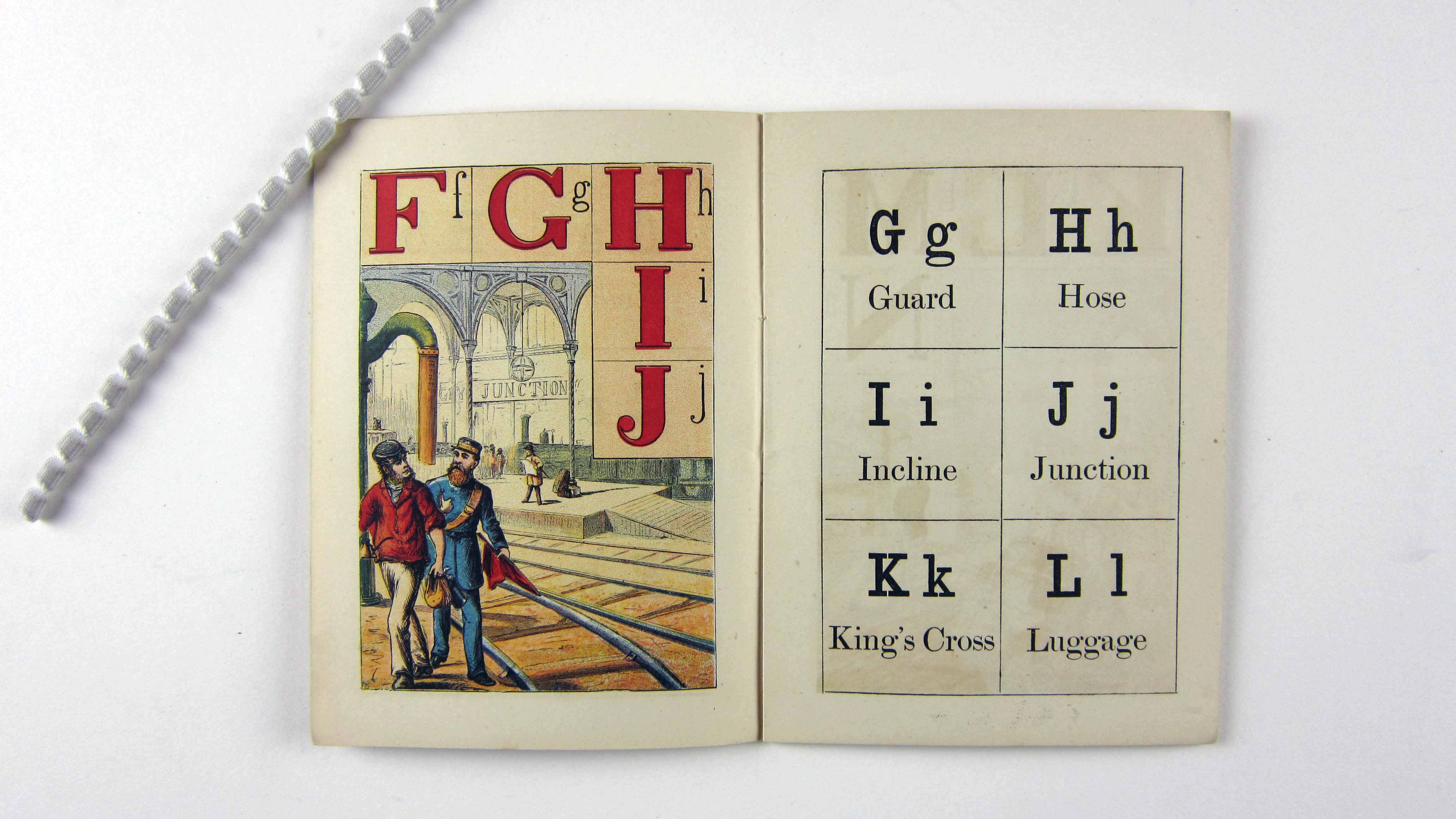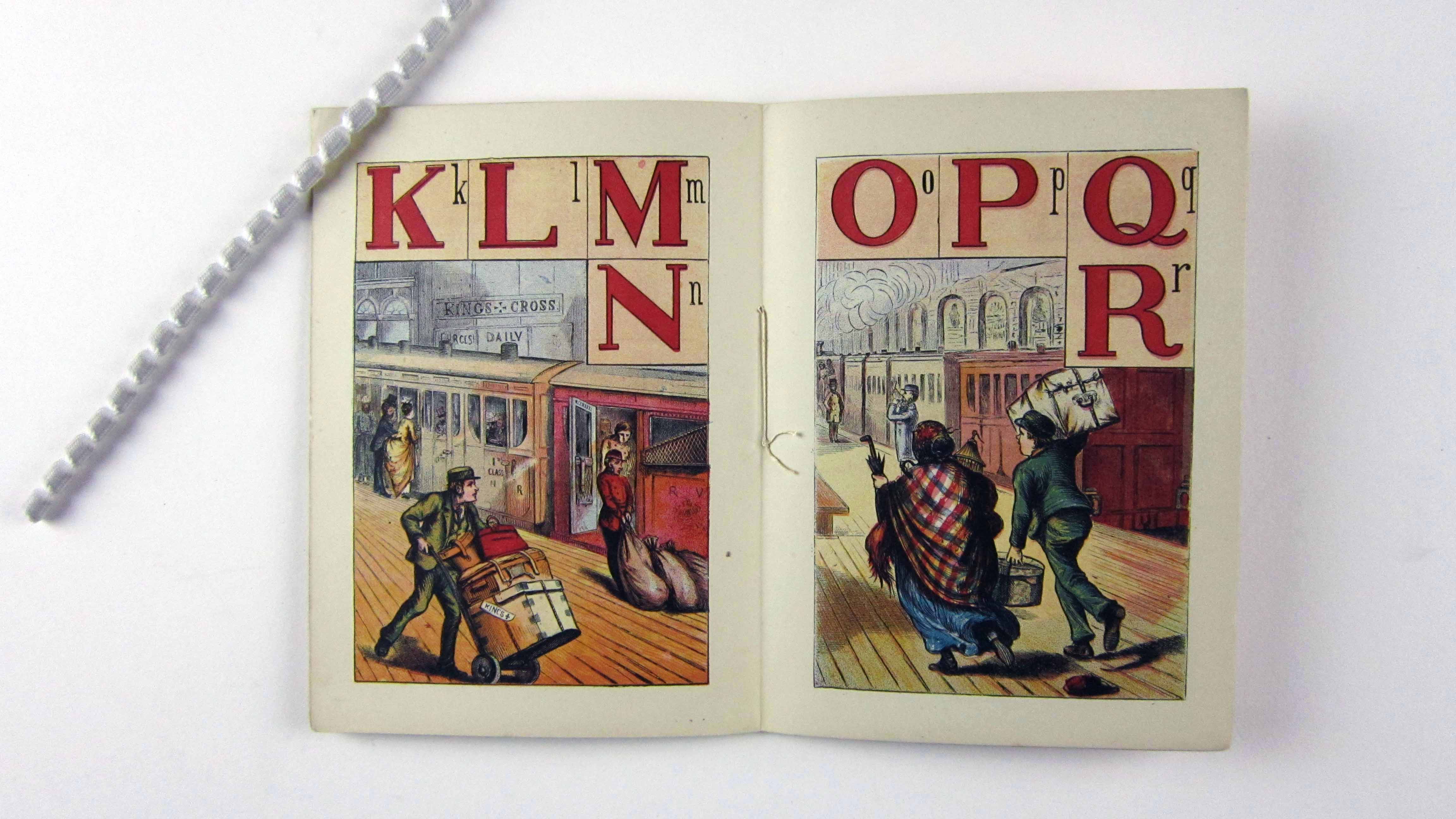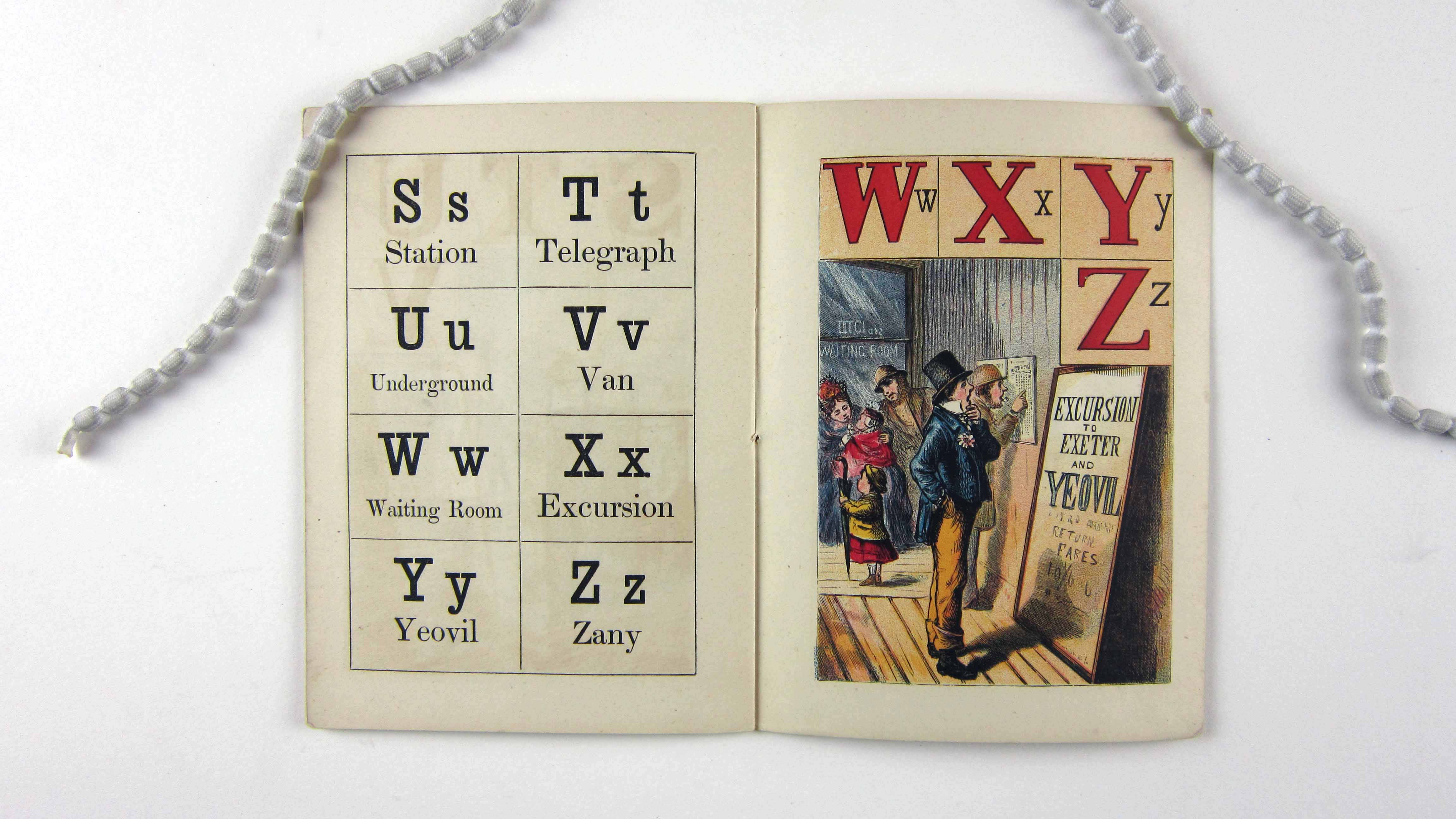

Alphabet books offer a vivid insight into the history of literacy and culture, as well as concepts of childhood. The Children's Book Collection at UCLA contains a rich array of these materials, some well-worn and much-used, some still bright and fresh. Each is a gem of print production and graphical imagery from another time and place. Though the history of alphabet books continues to the present, this exhibit focuses on the works in our collections published between 1700 and 1900, including horn books, primers, works of didacticism and seriousness, whimsy and play.
2. A Jumble ABC
3. A Little Pretty Pocket-Book
4. A New Lottery Book of Birds And Beasts
5. A Pretty Play-Thing for Children of All Denominations
8. ABC of Objects for Home And School
10. ABC with Pictures & Verses
12. Alphabet Et Instruction Pour Les Enfans
16. Dolly's ABC Book
17. Flora's ABC
18. Home ABC
22. Hornbook C. 1700
23. Large Letters for the Little Ones
24. Little ABC Book
25. Little People: An Alphabet
26. Martin's Nursery Battledoor
27. Mother Goose ABC
28. My Darling's ABC
29. Orbis Sensualium Pictus Quadrilinguis
30. People of All Nations: A Useful Toy for Girl Or Boy
31. Picture Alphabet
32. Pretty ABC
33. Railway ABC
34. Rusher's Reading Made Most Easy
38. The Alphabet of Old Friends
40. The Amusing Alphabet for Young Children Beginning To Read
42. The Child's Christian Education
45. The Easter Gift
47. The Favorite Alphabet for the Nursery
49. The Franklin Alphabet And Primer
51. The Golden ABC
55. The Moral And Entertaining Alphabet
57. The Old Testament Alphabet
59. The Picture Alphabet for Little Children
62. The Sunday ABC
63. The Union ABC
64. The Young Child's ABC, Or, First Book
65. Tom Thumb's Alphabet: Picture Baby-Books
67. Warne's Alphabet And Word Book: with Coloured Pictures
68. Wood's Royal Nursery Alphabet
Title Railway ABC





Brief description Series: Routledge's threepenny toy-books Notes: Cover title. Approximate dates established from Brown, P. London publishers and printers c. 1800-1870, p. 167. Chromolithographed illustrations. Series from publisher's advertisement on lower wrapper. First and last leaves pasted-down to wrappers. Publisher's printed pink wrappers; upper wrapper printed in black, red, and blue; publisher's advertisement on lower wrapper. Ex libris Elvah Karshner.
Full description In Railway ABC, specific letters and word units are paired with illustrations depicting railroad mass-transit systems that quickly spread during the industrial revolution in the midst of the Victorian Era (1837-1901). Railway books became quite common during these years.
As is the case with most ABC books, they absorbed contemporary culture and presented it to children as a way to both convey societal norms and teach the abstract alphabet with familiar concepts and images--in this case a society that embodied transportation and industry. Detailed lithographs are surrounded by large, block letters, visually connecting the image to an alphabetical context.
In addition, on pages opposing the lithographs, there are more traditional letters, paired with words that relate to the image: Aa is for Arch, Bb is for Bridge, etc. The different skill levels required to associate alphabet-to-image in this book represents different levels of assumed readership, from a beginner to intermediate learner. People in the images interact with machines, and it seems, machines help people along to their respective destinations.
Literacy In many ways the Industrial Revolution, which left an indelible imprint in 18th and 19th century Britain, stilted the progress that educational structures had worked so purposefully to build upon. Books such as Railway ABC were printed in mass volumes, yet were largely unavailable to the poorer segment of the population.
Working class children often worked in fields or factories and class distinctions created a rigid societal educational dichotomy: the upper-classes had leisure and support to learn, the lower-classes saw leisure and time (and thus, schooling) as a wish withheld. The technological revolution in Britain predated the advent of organized schooling, causing a great deal of disruption and uprising in society (there are many theories as to how this influenced the spread of industry in England).
Educational rhetoric and responsibilities begin to be appropriated by government and public entities on a larger scale than in the 17th and 18th centuries, with sweeping literacy reform to the benefit of the economy--for a "good" economy was thought to be made of the "educated" masses, educated with basic skills to lead industry into the future.
As such, books like Railway ABC served the purpose of both supporting the mass literacy movement, as well as supporting the ideology that the new trains systems were a virtuous part of society. Indeed, the framework for education also became mechanized, with literate individuals seen as the cogs of a massive, productive machine.
The effectiveness and validity of such a movement aside, a greater interest in "education" as a social construct emerged during the latter 19th century, delineated by clear ethical, and organizations ideals in consort with the foundation of good writing, reading and grammatical skills. Education began to take hold, taxation and governmental contributions began to subsidize education; mass literacy gained a stronger foothold and began to spread.
Childhood As we enter the mid-19th century, what was once a na跳ve child is now a child with bona fide social responsibilities--as are the children and young adults working the railway in Railway ABC. Children were engaged in various levels of work as part of their daily existence, oftentimes hired as manual laborers in the railroad industry, which required little education and a great deal of physical labor.
The clean illustrations in Railway ABC seem to stand in contrast to the true sooty, hard-working existence of the working life, depicting the railway industry in the most positive light possible in bright lithographs. The children in these images may be working (dragging bags, carting luggage), but their work is glossed over with a grander purpose: to keep an ordered society in motion.
On the final illustrated panel, a child stands in the background, yellow jacket and knee-length skirt situated just right, with a fitted hat and wood-handled umbrella (expensive, no doubt!); this is a child of the mid- to upper-class, readying with their family to board to train to some destination. As delicate as these pictures might seem, they keep two classes of children simultaneously at play: those children who moved on railways, and those who facilitated the moving.
Male children dominate the pages of Railway ABC, perhaps indicating a young, male audience. The railway industry is romanticized to attract ridership, as well as a younger generation of boys eager to work in a profession whose reality was far harsher than these children's books tended to portray them.
Iconography The cover to this Railway ABC is bright pink, ornately bordered, with titles in harlequin letters, indicating "exotic" influence in its design. Railway ABC is worldly, busy, and depicts a Victorian English society in communication with other countries--a fact gleaned even before examining the book's content.
What may seem a simple ABC book (as its text is relatively simplistic) is culturally significant, illustrative of the industrial revolution, where words like "Bridge,""Engine," "Junction," and "Luggage" represent something new within a contemporary concept of a mechanized society.
The first image in the book is of a cattle train, beautifully colored, whose last train car vanishes into the distance. Perspective is real in these pictures, unlike the flat one-dimensional images common in the previous century. Faster transportation is a reality, bridging the rural past to the present time of 1865 travel and communication. Cattle are moved quickly, bringing the countryside in to the city; classes and segmented populations within England intermingle.
People are in movement in these pictures, or asking other people to "come along" toward the "Junction." Passengers cart luggage or linen bags the size of their bodies, eager to make that "excursion" depicted at the terminus of the alphabet's "Ww/Xx/Yy/Zz."
In Railway ABC, the connection between letter and image (as in "S is for Station") is subsumed by the overarching narrative of travel. "Aa" isn't so much connected with the image of the "Arch" at the beginning of the text, nor "Yz" with the destination "Yoevil" (though, that does exist to a certain extent), as much as the emphasis on the connection between how one gets from the "Arch" to the destination of Yeovil, England. Your present location is connected to the destination of your travels at some future point.
Communication via travel is underscored by the "Telegraph Office" illustrated beside "Ss/Tt/Uu/Vv." A new era of technology is being communicated--a technological literacy is being advanced, hand-in-hand with a traditional ABC book format tweaked for contemporary and modern ends.
Production As industrialization expanded in Victorian England, cheap labor usig children was readily available--a good deal of whom worked in factories and publishing print houses. George Routledge and Sons, the printer of this Railway ABC, was an instrumental publisher in mass marketing inexpensive children's titles, before it became known as the scholarly and academic titan of publishing it is today.
Serialized publishing begins to take shape in this period, as this "Threepenny Toy-Book" indicates on the back cover, part of a larger collection of playful books for children with such titles as Farm-Yard Alphabet, Nursery Songs, Mother Goose and The Five Little Pigs. Of particular significance, as indicated on the cover of Railway ABC, George Routledge and Sons was based in both London and New York--distant locations connected by lucrative book businesses.
As the 19th century progressed and book volumes increased and spread, publishers strategically advertised the content of books to different genders--with this example marketed toward the young male segment of the population.
Chromolithography, as in Railway ABC, became the primary means to produce colorful, attractive books. Railway ABCs are common in the publishing industry during this period, as it served to advertise the beauty of machinery and technological advancements, in a society struggling to keep up with the pace of improvement.
Publisher George Routledge and Sons: Kronheim & Co.
Publication place New York
Date 1865
UCLA Call Number CBC PE1119.A1 R35 1865
Repository UCLA Charles E. Young Research Library, Dept. of Special Collections
Dimensions 131 mm x 181 mm
Technologies of production Chromolithography
Caption